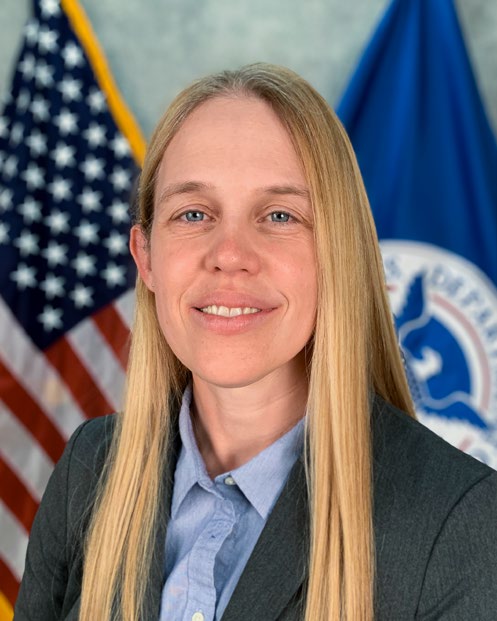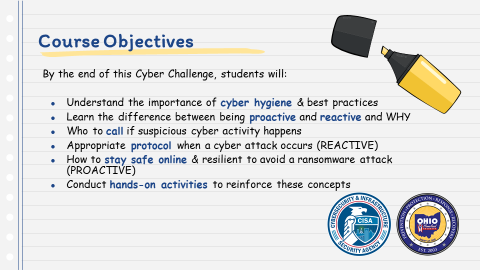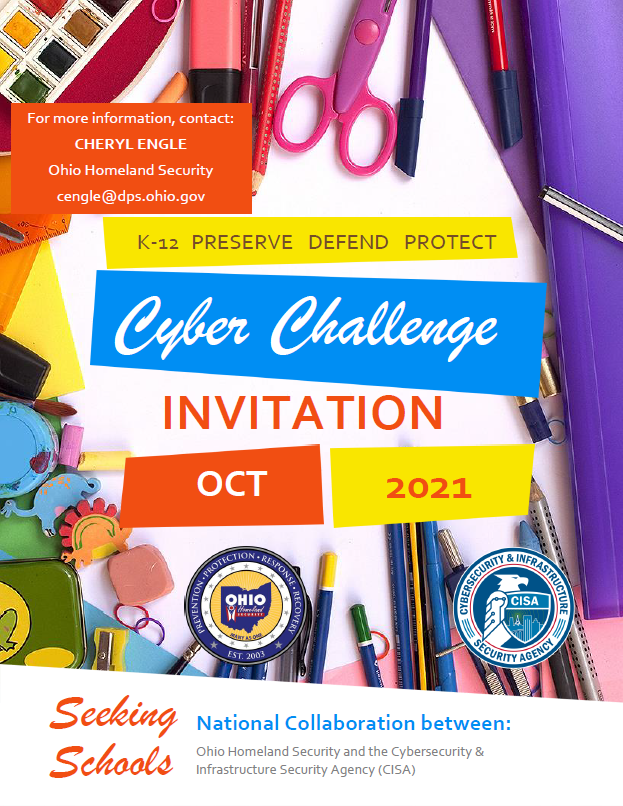Recent malware attacks against American businesses have prompted greater awareness of cyber threats nationwide. Government and private entities are gearing up to ward off such attacks, but what about K-12 schools and the young people they serve? Do educators and children need to become “cyber safe” in school and at home? And, if so, how do they get started? One way is through the K-12 Cyber Challenge, which aims to help school staff members and their students become knowledgeable about cybersecurity and prepared to thwart cyberattacks. To find out more, we contacted Cheryl L. Engle, cyber program manager with Ohio Homeland Security, who is helping to coordinate the program:
Q: Tell us about the K-12 Cyber Challenge.

A: The K-12 Cyber Challenge is a national collaboration between Ohio Homeland Security (OHS) and the Cybersecurity & Infrastructure Security Agency (CISA) out of Washington, D.C. Our goal is to educate K-12 students, teachers and IT administrators about the importance of cybersecurity and what to do proactively and reactively in the event of a ransomware or cyberattack.
This idea was born from a discussion I had with Ohio’s cybersecurity adviser, Col. Terin Williams of CISA, in June 2021. We were talking about the ransomware attacks to the Colonial Pipeline (April 2021) and the JBS Foods meat packaging plants (May 2021) and the importance of being cyber ready.
So many CISA initiatives have been geared toward the business owner, government agencies and manufacturing plants that K-12 schools would be a new audience.
Q: Who can participate in the challenge?

A: Presently, the Cyber Challenge is being rolled out to K-12 students, teachers, technology managers and school administrators across Ohio.
In response to the rise in malicious cyber activity against K-12 and higher education institutions and the increase in remote learning, CISA launched a comprehensive “Back to School” cybersecurity awareness campaign in tandem from Aug. 9-30, 2021, to highlight the importance of cybersecurity and to build awareness of cyber risks in the school setting.
Q: How does the Cyber Challenge differ for each school group?
A: The Cyber Challenge curriculum has been tailored to fit grades K-3, 4-8 and 9-12. With technology savvy students, real world examples are illustrated to show them how to protect themselves on social media, the importance of placing their cellphones in airplane mode to avoid connecting to open hotspots, what a ransomware splash screen looks like, how to protect themselves against identity theft and who to call if suspicious cyber activity occurs.
Q: How is the challenge conducted?
A: Students will be taught in a classroom setting with course objectives (see slide). We are working with the local technology managers and CISA to see whether a phishing email attempt could be deployed to the school districts because CISA has a platform with that capability.
Col. Williams and I premiered the K-12 Cyber Challenge to the Lakota Local Schools near Cincinnati, and administrators talked about rolling it out as a Train-the-Trainer simulation with Cyber 3 students (grade 12) teaching the younger students (grades K-11).
School administrators were also interested in using the Cyber Challenge as a recruitment tool for students in grades 8-9 interested in enrolling in the Lakota Schools Cyber 1-2-3 program (grades 10-12).

Q: Is there a cost for those participating?
A: There is no student cost to participate in the Cyber Challenge. Representatives from Ohio Homeland Security, CISA and the Ohio Cyber Reserve (trained volunteers) would visit your school for a day to conduct the Cyber Challenge.
 Q: When will the challenge be conducted?
Q: When will the challenge be conducted?
A: The Cyber Challenge will be conducted throughout the 2021-2022 academic year. Future plans center around me and Col. Williams recording this K-12 Cyber Challenge as an open-source VOD (video on demand). That way we could roll out this program to all Ohio teachers where they could pull down the curricula and customize their instruction for their various grade levels. This is a great way to scale-up quickly and roll out nationally. We are targeting a full-scale release for Oct. 1, 2021, Cybersecurity Awareness Month.
Q: How do schools/individuals register to participate or get more information?
A: Below you will find a publicity poster seeking K-12 schools to schedule an onsite learning session. Contact me, Cheryl Engle, cyber program manager, Ohio Homeland Security, at [email protected] to arrange a visit.
Q: Is there anything else you would like to share about the K-12 Cyber Challenge?
A: With the current threat landscape of cyberattacks and ransomware on the rise, we invite your school to participate in the K-12 Cyber Challenge. We’ll teach you how to stay safe online and resilient in the face of a cyberattack; who to call if suspicious cyber activity occurs; how to stay connected on your mobile device, tablet or iPad; how to create a social media presence; and how to defend your school, community and state.
Students will be taught what it means to be cyber safe and secure at home, at school and on their mobile device.
Come join us for the Cyber Challenge, and keep America safe!